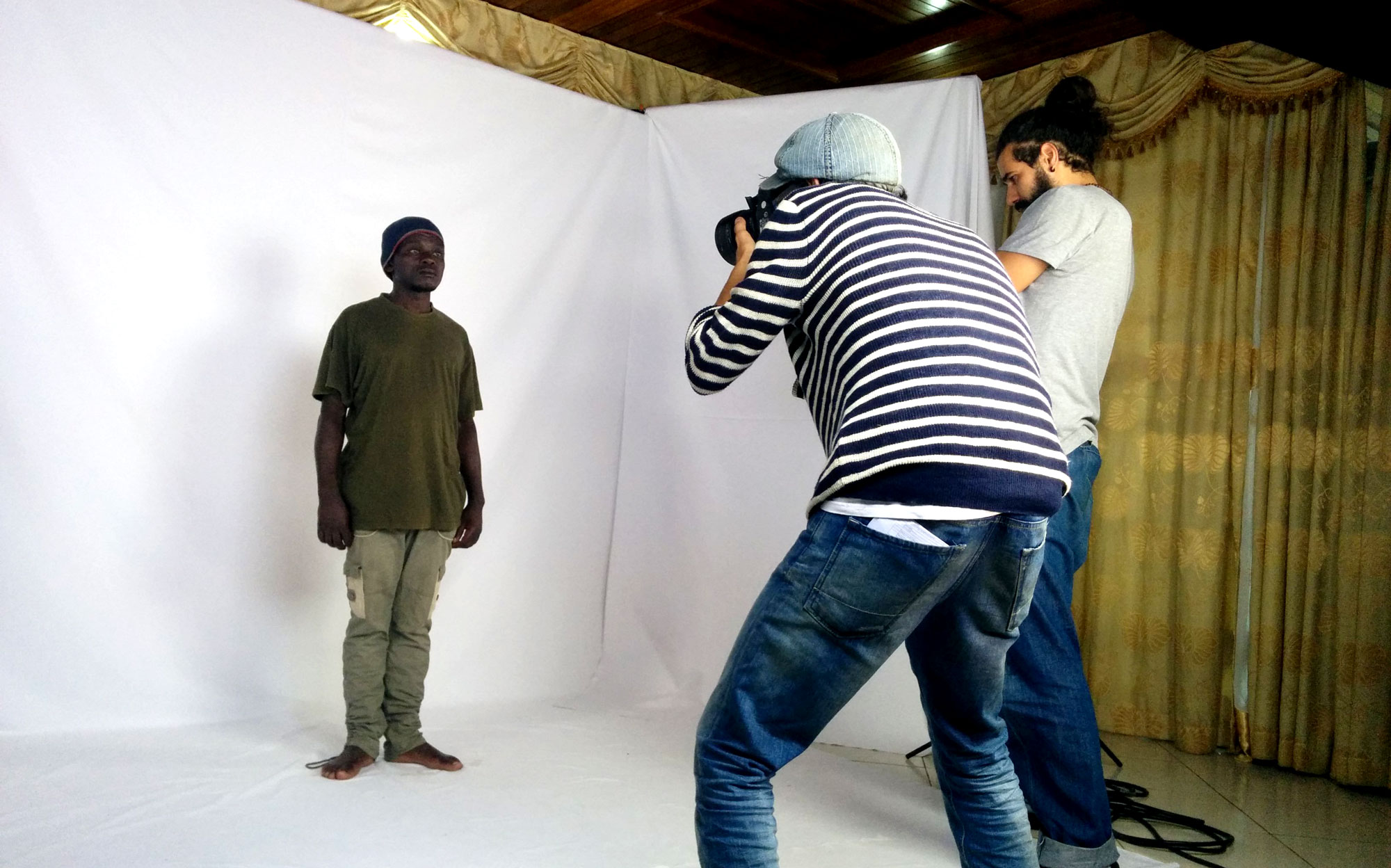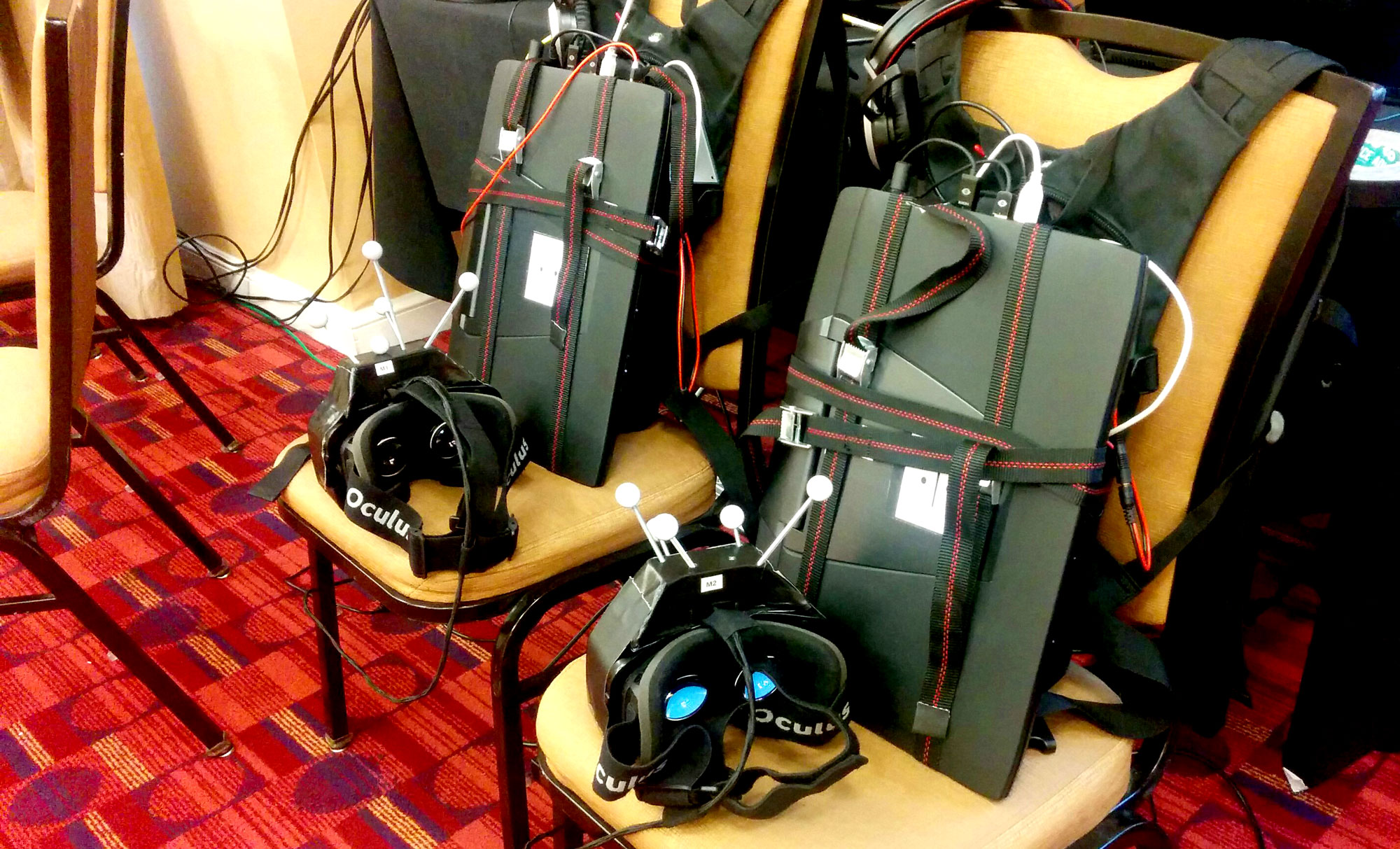THE ENEMY
Making Of
Par Fabien Barati – Part 5/7
Congo
The second conflict dealt with in The Enemy is the civil war in Rwanda. Some belligerents are still hiding at the border, on the Democratic Republic of the Congo side. The conflict has persisted for decades between these rebels and the Congolese army.
To prepare for our captures on the field, we organized new tests at Emissive offices in September 2015. Indeed, our experience from Tel Aviv and Gaza led us to slightly alter our technical choices.
We tested a photogrammetry technique to capture the combatants’ faces, which seemed very promising. We also had to add the ability to capture various movements, such as walking. But the most important test was to achieve perfect capture quality for black skins. Jean-Gabriel took this opportunity to use different cameras and lighting.

Capture tests at Emissive offices
Jean-Gabriel and I left with all the equipment on October 4th, 2015. We joined Karim and Selim who were already there for sighting purposes, helped by our fixer, Adolphe. After a (memorable) stopover in Amsterdam, where we were delayed due to bad weather, we finally arrived in Kigali, the capital of Rwanda. But our equipment did not follow and was scattered between Paris, Amsterdam and… Istanbul. After 3 days waiting, we finally left for Goma, our final destination on the Congo side of the border.
We met Karim and Selim in the hotel where we were going to spend the week. As soon as he arrived, Jean-Gabriel transformed the living room of our suite into a studio. Everything was ready to receive the combatants.

Jean-Gabriel setting up the capture studio in Goma
Adolphe and Karim did a remarkable job: we were able to interview 7 combatants from three different armed groups. The logistics associated with their arrival (which had to remain absolutely secret) would deserve its own article; not to mention all the preparation, organisation and authorization work carried out by Camera Lucida.
The capture was carried out in a similar fashion as in Israel and Palestine, with some additions.
Motion capture
Initially, we decided that the combatants would remain still in the VR experience. Before leaving for Congo, we decided to add some behaviour elements and make them mobile. So we had to capture these movements in the real world. We added this phase during the interviews. The combatants were filmed while making a precise list of movements: walking, hand signals, greetings… even the way they turned to face us. Once again, we made extensive efforts to faithfully capture their way of moving and expressing themselves.
Photogrammetry
Modelling faces is an extremely tedious job when you only have a few photos and a low-quality 3D scan to work with. Starting with the second conflict, in Congo, we decided to use photogrammetry to model the combatants’ faces.
Photogrammetry is a process that automatically recreates a 3D object from photos. It requires taking many shots under strong constraints: no blur, enough visual cues between the photos, avoid glare and reflections, and above all, the subject must remain perfectly still.
In order for the combatants to remain as still as possible, we needed to work very quickly. Going around taking pictures was too slow. We had the idea to have them sit on a swivel chair that would rotate smoothly. We would rotate them manually in front of four fixed cameras, all triggered simultaneously. For more stability during the rotation, Jean-Gabriel created a headrest using pliers and supporting arms.
It was a stressful step. We needed to act fast and examine the combatants’ every move. If they moved too much, we had to do it again. I was turning the chair little by little, punctuating every mini-rotation with a “top!” signalling Jean-Gabriel and Selim to take pictures. And we had to wait to get back to Paris to know if the quality was good or not.

Photogrammetry session for a Congolese combatant
A difficult shoot
In Congo, there were several disruptive elements that significantly lengthened our capture time. These situations are not insignificant. It is difficult to assess the combatants’ reaction if you ask them to do additional takes or stay longer than expected in a place that can be dangerous for them (and for us).
Here are some examples:
- Unduly and regular power cuts in Goma
- UN and army helicopters constantly and loudly flying over the hotel, forcing us to restart our interviews several times
- Live translation by the interpreter was difficult in Swahili
- The cameras were heating up and triggering safe mode
But in the end, we were very satisfied with the result. The combatants delivered very strong messages and we collected seemingly good quality data.
In addition to the interviews, we had the chance to attend a local mass, and to visit an opencast mine a few miles from Goma. For me, it was one of the most rewarding trips I have ever been on.

Karim and Selim taking pictures of a Congolese soldier
Credibility of the virtual environment
A successful immersion in virtual reality requires all visible elements to be perfectly coherent. Nothing must stand out. It can be a cartoon world, black and white or impressionistic, as long as everything respects the same graphic language.
The Enemy aims for ultra-realism: everything in the environment looks real and reacts in a credible manner to surrounding elements.
What is true for virtual combatants also applies to surrounding rooms, and the lighting. Glare, reflections and shadows had to be carefully adjusted to attain a realistic feel, a form of unity.
On a technical level, we use PBR materials that realistically react to lighting, and light probes that allow us to pre-calculate the lighting environment. The final rendering is calculated in real time to obtain accurate shadows and reflections that follow the actions of combatants and users.
That’s also why the lighting used during the capture of the real combatants had to be as constrained as possible: all the lighting effects are calculated afterwards.
In the end, you obtain an overall coherent result: you know that it works when no one notices it!

Lighting and material quality are essential to overall realism
Second Prototype : Multiuser
Portable system
The second prototype of The Enemy was intended to validate the multi-user aspect and integrate more content, including Rwandan and Congolese combatants.
With the first prototype, the user was connected to a PC through a long cable. We couldn’t apply this system to several participants. Indeed, even with only two people, we couldn’t prevent the cables from becoming entangled or the users from tripping.
That’s why we had to create a portable system that each user could move around with, throughout the experience. The basic idea was simple: carry a sufficiently powerful laptop on their back.
Unfortunately, a full-powered laptop only has about ten minutes of battery life! So we couldn’t properly test the experiment in these circumstances.
Anthony Boussolier, with whom we’ve worked for several years, designed and implemented a bespoke solution.
Les PC portables allaient être alimentés par une batterie de vélo électrique.
Anthony customized backpacks to fit the battery, an electrical transformer and the laptop computer, so that we could have several hours of battery life to work with! He even added a very useful switch on the top of the backpack to turn on the device. The only drawback was the weight: 11 kilos to carry for 50 minutes!
We knew that this would not be our final iteration, but this solution helped us make great strides in our development process and in adjusting the scenario.

The second prototype’s portable VR system: a laptop and an electric bike battery (hidden behind the laptop in this picture)
Collaborative platform
Tests were carried out in the Triangle Room of the Centre Pompidou, at the Agora of the Cité des Sciences, and at MIT in Boston. We took this opportunity to integrate more content with the selected Congo combatants: Jean de Dieu and Patient.
We were also able to validate an extremely important component of the project, i.e. the network layer, which allows participants to see each other. This was the first time we used this technological building block. Concretely, we have developed a software capable of having the users’ computers communicate with each other; monitor the experience remotely, as well as any occurrence, normal or abnormal. The software is hosted on the master computer. Communication is achieved via standard WiFi network, and optimised with Anthony’s help.

Multiuser tests. On the left we can see electric bike batteries charging.
THE ENEMY
MAKING OF

Emissive
71 rue de Provence
75009 Paris – FRANCE
+33 1 49 53 09 26